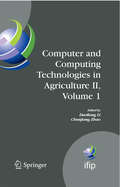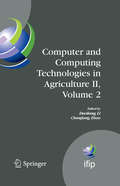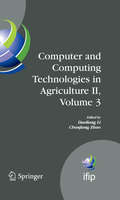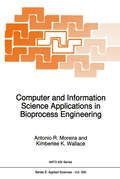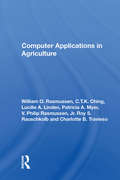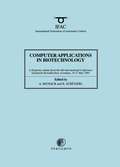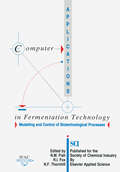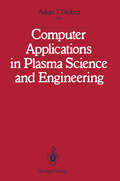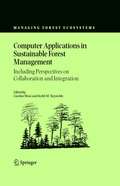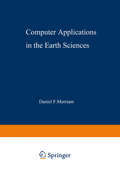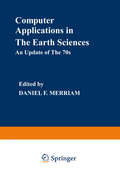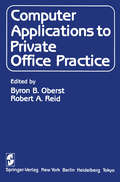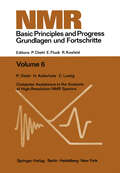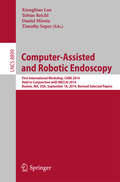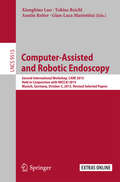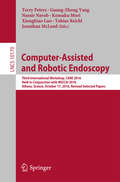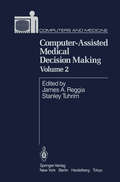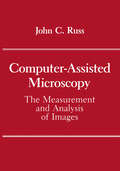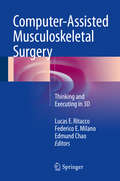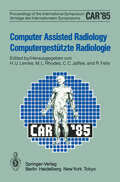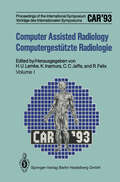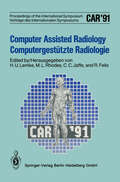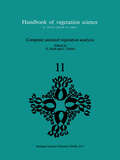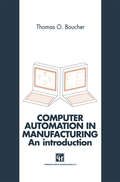- Table View
- List View
Computer and Computing Technologies in Agriculture II, Volume 1: The Second IFIP International Conference on Computer and Computing Technologies in Agriculture (CCTA2008), October 18-20, 2008, Beijing, China (IFIP Advances in Information and Communication Technology #293)
by Chunjiang Zhao Daoliang LiThe papers in this volume comprise the refereed proceedings of the Second IFIP International Conference on Computer and Computing Technologies in Agriculture (CCTA2008), in Beijing, China, 2008. The conference on the Second IFIP International Conference on Computer and Computing Technologies in Agriculture (CCTA 2008) is cooperatively sponsored and organized by the China Agricultural University (CAU), the National Engineering Research Center for Information Technology in Agriculture (NERCITA), the Chinese Society of Agricultural Engineering (CSAE) , International Federation for Information Processing (IFIP), Beijing Society for Information Technology in Agriculture, China and Beijing Research Center for Agro-products Test and Farmland Inspection, China. The related departments of China’s central government bodies like: Ministry of Science and Technology, Ministry of Industry and Information Technology, Ministry of Education and the Beijing Municipal Natural Science Foundation, Beijing Academy of Agricultural and Forestry Sciences, etc. have greatly contributed and supported to this event. The conference is as good platform to bring together scientists and researchers, agronomists and information engineers, extension servers and entrepreneurs from a range of disciplines concerned with impact of Information technology for sustainable agriculture and rural development. The representatives of all the supporting organizations, a group of invited speakers, experts and researchers from more than 15 countries, such as: the Netherlands, Spain, Portugal, Mexico, Germany, Greece, Australia, Estonia, Japan, Korea, India, Iran, Nigeria, Brazil, China, etc.
Computer and Computing Technologies in Agriculture II, Volume 2: The Second IFIP International Conference on Computer and Computing Technologies in Agriculture (CCTA2008), October 18-20, 2008, Beijing, China (IFIP Advances in Information and Communication Technology #294)
by Chunjiang Zhao Daoliang LiThe papers in this volume comprise the refereed proceedings of the Second IFIP International Conference on Computer and Computing Technologies in Agriculture (CCTA2008), in Beijing, China, 2008. The conference on the Second IFIP International Conference on Computer and Computing Technologies in Agriculture (CCTA 2008) is cooperatively sponsored and organized by the China Agricultural University (CAU), the National Engineering Research Center for Information Technology in Agriculture (NERCITA), the Chinese Society of Agricultural Engineering (CSAE) , International Federation for Information Processing (IFIP), Beijing Society for Information Technology in Agriculture, China and Beijing Research Center for Agro-products Test and Farmland Inspection, China. The related departments of China’s central government bodies like: Ministry of Science and Technology, Ministry of Industry and Information Technology, Ministry of Education and the Beijing Municipal Natural Science Foundation, Beijing Academy of Agricultural and Forestry Sciences, etc. have greatly contributed and supported to this event. The conference is as good platform to bring together scientists and researchers, agronomists and information engineers, extension servers and entrepreneurs from a range of disciplines concerned with impact of Information technology for sustainable agriculture and rural development. The representatives of all the supporting organizations, a group of invited speakers, experts and researchers from more than 15 countries, such as: the Netherlands, Spain, Portugal, Mexico, Germany, Greece, Australia, Estonia, Japan, Korea, India, Iran, Nigeria, Brazil, China, etc.
Computer and Computing Technologies in Agriculture II, Volume 3: The Second IFIP International Conference on Computer and Computing Technologies in Agriculture (CCTA2008), October 18-20, 2008, Beijing, China (IFIP Advances in Information and Communication Technology #295)
by Chunjiang Zhao Daoliang LiThe papers in this volume comprise the refereed proceedings of the Second IFIP International Conference on Computer and Computing Technologies in Agriculture (CCTA2008), in Beijing, China, 2008. The conference on the Second IFIP International Conference on Computer and Computing Technologies in Agriculture (CCTA 2008) is cooperatively sponsored and organized by the China Agricultural University (CAU), the National Engineering Research Center for Information Technology in Agriculture (NERCITA), the Chinese Society of Agricultural Engineering (CSAE) , International Federation for Information Processing (IFIP), Beijing Society for Information Technology in Agriculture, China and Beijing Research Center for Agro-products Test and Farmland Inspection, China. The related departments of China’s central government bodies like: Ministry of Science and Technology, Ministry of Industry and Information Technology, Ministry of Education and the Beijing Municipal Natural Science Foundation, Beijing Academy of Agricultural and Forestry Sciences, etc. have greatly contributed and supported to this event. The conference is as good platform to bring together scientists and researchers, agronomists and information engineers, extension servers and entrepreneurs from a range of disciplines concerned with impact of Information technology for sustainable agriculture and rural development. The representatives of all the supporting organizations, a group of invited speakers, experts and researchers from more than 15 countries, such as: the Netherlands, Spain, Portugal, Mexico, Germany, Greece, Australia, Estonia, Japan, Korea, India, Iran, Nigeria, Brazil, China, etc.
Computer and Information Science Applications in Bioprocess Engineering (NATO Science Series E: #305)
by A. R. Moreira Kimberlee K. WallaceBiotechnology has been labelled as one of the key technologies of the last two decades of the 20th Century, offering boundless solutions to problems ranging from food and agricultural production to pharmaceutical and medical applications, as well as environmental and bioremediation problems. Biological processes, however, are complex and the prevailing mechanisms are either unknown or poorly understood. This means that adequate techniques for data acquisition and analysis, leading to appropriate modeling and simulation packages that can be superimposed on the engineering principles, need to be routine tools for future biotechnologists. The present volume presents a masterly summary of the most recent work in the field, covering: instrumentation systems; enzyme technology; environmental biotechnology; food applications; and metabolic engineering.
Computer Applications In Agriculture
by William Otto RasmussenU.S. agriculture appears to be at a major turning point in terms of technological change and innovation as it enters the information age[1]and at the heart of the information revolution is the microcomputer. This handbook explains in practical terms how computers are being used in agriculture and analyzes some of the issues surrounding present and potential computer applications. The authors define agriculture in the broadest possible terms, including the traditional aspects of farming, the industries supporting agriculture, service bureaus related to agriculture, classroom instruction and youth development, and the rural family and community. Considered are specific ways microcomputers are changing agriculture, the exact nature of these changes, and how agriculturists are currently adapting microprocessor technology to make agriculture more efficient and viable. Also included is a discussion of the computer software and hardware used in agriculture today, hardware and software purchasing strategies for both individuals and institutions, and sources of information on computer applications in agriculture.
Computer Applications In Agriculture
by William Otto RasmussenU.S. agriculture appears to be at a major turning point in terms of technological change and innovation as it enters the information age[1]and at the heart of the information revolution is the microcomputer. This handbook explains in practical terms how computers are being used in agriculture and analyzes some of the issues surrounding present and potential computer applications. The authors define agriculture in the broadest possible terms, including the traditional aspects of farming, the industries supporting agriculture, service bureaus related to agriculture, classroom instruction and youth development, and the rural family and community. Considered are specific ways microcomputers are changing agriculture, the exact nature of these changes, and how agriculturists are currently adapting microprocessor technology to make agriculture more efficient and viable. Also included is a discussion of the computer software and hardware used in agriculture today, hardware and software purchasing strategies for both individuals and institutions, and sources of information on computer applications in agriculture.
Computer Applications in Biotechnology (IFAC Postprint Volume)
by A. Munack K. SchönertThe 6th Computer Applications in Biotechnology (CAB6) conference was a continuation of 2 series of events: the IFAC symposia on Modelling and Control of Biotechnical Processes and the International Conferences on Computer Applications in Fermentation Technology. This conference provided the opportunity for both sides, leading researchers and industrial practitioners, in this interdisciplinary field to exchange new ideas and technology; concepts and solutions. This postprint volume contains all those papers which were presented at the conference.
Computer Applications in Fermentation Technology: Modelling and Control of Biotechnological Processes
by N. M. FishRichard Fox Chairman, Scientific Programme Committee Between 25th and 29th September, 1988, 243 people who either apply or research the use of computers in fermentation gathered together at Robinson College, Cambridge, UK. They came from 30 countries. The conference brought together two traditions. Firstly, it continued the series on Computer Applications in Fermentation Technology (ICCAFT) inaugurated by Henri Blanchere in Dijon in 1973 and carried forward in Philadelphia and Manchester. Secondly, it brought the expertise of the many members of the International Federation of Automatic Control (IFAC), who focused their attention on biotechnology at Noordwijkerhout in the Netherlands in December, 1985. I am happy to say that the tradition carries on and a successor meeting will hopefully take place in the USA in 1991. If you find these proceedings useful or stimulating, then we hope to see you there. We set out to make ICCAFT4 a close-knit friendly conference. We housed all who cared to in Robinson College itself and organised no parallel sessions. Because we, the organisers, experience difficulty with the jargon of our colleagues from other disciplines, we asked Bruce Beck to present a breakfast tutorial on modern control and modelling techniques, and we set up informal panel discussions after dinner on two evenings. Neville Fish chaired a forum on the microbiological principles behind models, while Professors Derek Linkens and Ron Leigh led a discussion on expert systems in control.
Computer Applications in Plasma Science and Engineering
by Adam T. DrobotThis volume, which contains 15 contributions, is based on a minicourse held at the 1987 IEEE Plasma Science Meeting. The purpose of the lectures in the course was to acquaint the students with the multidisciplinary nature of computational techniques and the breadth of research areas in plasma science in which computation can address important physics and engineering design issues. These involve: electric and magnetic fields, MHD equations, chemistry, radiation, ionization etc. The contents of the contributions, written subsequent to the minicourse, stress important aspects of computer applications. They are: 1) the numerical methods used; 2) the range of applicability; 3) how the methods are actually employed in research and in the design of devices; and, as a compendium, 4) the multiplicity of approaches possible for any one problem. The materials in this book are organized by both subject and applications which display some of the richness in computational plasma physics.
Computer Applications in Sustainable Forest Management: Including Perspectives on Collaboration and Integration (Managing Forest Ecosystems #11)
by Guofan Shao Keith M. ReynoldsThis book is the most comprehensive and up-to-date treatment of computer applications in forestry. It is the first text on software for forest management to emphasize integration of computer applications. It also offers important new insights on how to continue advancing computational technologies in forest management. The authors are internationally-recognized authorities in the subjects presented.
Computer Applications in the Earth Sciences: An International Symposium Proceedings of a conference on the state of the art held on campus at The University of Kansas, Lawrence on 1618 June 1969. Sponsored by the Kansas Geological Survey, International Association for Mathematical Geology, and University of Kansas Extension (Computer Applications in the Earth Sciences)
by Daniel F. MerriamIt has been evident for several years that a summary of where we came from, where we are, and where we are going with computer-oriented research was not only desir able but necessary. The application of computers by earth scientists is numerous and the methods have proved of val ue in problem solving as well as data processing. Many methods unknown or unavailable just a few years ago now are used routinely. An overall appraisal of the methods at this time is deemed more than appropriate. Preface to the program was stated as Computer applications in the earth sciences is the subject of this International Symposium held on campus at The University of Kansas at Lawrence on 16, 17, and 18 June 1969. The symposium, the sixth in a series, is sponsored by the Kansas Geological Survey, International As sociation for Mathematical Geology, and University Extension. Papers by leading experts in their field stress the "status-of-the-art." Speakers will discuss the use of computers in the earth sciences, past, present, and future. The meeting is planned for those not acquainted with the tremendous ad vancements made in quantitative methods in recent years and those who are interested in future pos sibilities.
Computer Applications in the Earth Sciences: An Update of the 70s (Computer Applications in the Earth Sciences)
by Daniel F. MerriamComputer Applications to Private Office Practice
by E. Gabrieli J. H. Hoskins J. M. Long G. Murphy B. B. Oberst R. A. ReidThis publication is sponsored by the American Association for Medical Systems and Informatics. The Board of AAMSI and the Board of the Society for Computer Medicine, one of AAMSI's predecessors, agreed that a book on application of medical systems and informatics for the practitioner would help promote high quality health care and they charged the Committee on Standards of the Society for Computer Medicine to write such a text. It is intended as a guide for the field of medical systems and informatics with emphasis on standards, terminology, and coding systems. The text, a result of three years of research and effort, has been reviewed by the Board of Directors of AAMSI and approved by the Publications Committee. We believe that you will find it valuable and hope to revise it from time to time to meet current needs. On behalf of the members of the Association, we congratulate the authors and thank them for their efforts. WILLIAM A. BAUMAN, M.D. President American Association for Medical Systems and Informatics Preface This book has been written by the members of the Committee on Standards of the Society for Computer Medicine. We have drawn upon the Society's expertise to prepare an easy-to-read and understandable How-to Do-It text for use by those physicians who are considering computerization of their office in one manner or another.
Computer Assistance in the Analysis of High-Resolution NMR Spectra (NMR Basic Principles and Progress #6)
by P. Diehl H. Kellerhals E. LustigNuclear magnetic resonance spectroscopy, which has evolved only within the last 20 years, has become one of the very important tools in chemistry and physics. The literature on its theory and application has grown immensely and a comprehensive and adequate treatment ofall branches by one author, or even by several, becomes increasingly difficult. by experts workinginvarious This seriesis planned to present articles written fields of nuclear magnetic resonance spectroscopy, and will contain review articles as well as progress reports and original work. Its main aim, however, is to fill a gap, existing in literature, by publishing articles written by specialists, which take the reader from the introductory stage to the latest development in the field. The editors are grateful to the authors for the time and effort spent in writing the articles, and for their invaluable cooperation. The Editors Computer Assistance in the Analysis of High-Resolution NMR Spectra P. DIEHL and H. KELLERHALS Departmentof Physics, University ofBasle, Switzerland E. LUSTIG Food and Drug Administration, Washington, D.C., U.S.A.
Computer-Assisted and Robotic Endoscopy: First International Workshop, CARE 2014, Held in Conjunction with MICCAI 2014, Boston, MA, USA, September 18, 2014. Revised Selected Papers (Lecture Notes in Computer Science #8899)
by Xiongbiao Luo Tobias Reichl Daniel Mirota Timothy SoperThis book constitutes the refereed proceedings of the First International Workshop on Computer Assisted and Robotic Endoscopy, CARE 2014, held in conjunction with MICCAI 2014, in Boston, MA, USA, in September 2014. The 12 papers presented focus on recent technical advances associated with computer vision; graphics; robotics and medical imaging; external tracking systems; medical device control systems; information processing techniques; endoscopy; planning and simulation.
Computer-Assisted and Robotic Endoscopy: Second International Workshop, CARE 2015, Held in Conjunction with MICCAI 2015, Munich, Germany, October 5, 2015, Revised Selected Papers (Lecture Notes in Computer Science #9515)
by Xiongbiao Luo Tobias Reichl Austin Reiter Gian-Luca MariottiniThis book constitutes the thoroughly refereed post-conference proceedings of the Second International Workshop on Computer Assisted and Robotic Endoscopy, CARE 2015, held in conjunction with MICCAI 2015, in Munich, Germany, in October 2015. The 15 revised full papers were carefully selected out of 20 initial submissions and focus on recent technical advances associated with computer vision; graphics; robotics and medical imaging; external tracking systems; medical device control systems; information processing techniques; endoscopy; planning and simulation.
Computer-Assisted and Robotic Endoscopy: Third International Workshop, CARE 2016, Held in Conjunction with MICCAI 2016, Athens, Greece, October 17, 2016, Revised Selected Papers (Lecture Notes in Computer Science #10170)
by Terry Peters Guang-Zhong Yang Nassir Navab Kensaku Mori Xiongbiao Luo Tobias Reichl Jonathan McLeodThis book constitutes the thoroughly refereed post-conference proceedings of the Third International Workshop on Computer Assisted and Robotic Endoscopy, CARE 2016, held in conjunction with MICCAI 2016, in Athens, Greece, in October 2016. The 11 revised full papers were carefully selected out of 13 initial submissions. The papers are organized on topical secttion such as computer vision, graphics, robotics, medical imaging, external tracking systems, medical device controls systems, information processing techniques, endoscopy planning and simulation.
Computer-Assisted Medical Decision Making (Computers and Medicine)
by StanleyTuhrim James A. ReggiaComputer technology has impacted the practice of medicine in dramatic ways. Imaging techniques provide noninvasive tools which alter the diag nostic process. Sophisticated monitoring equipment presents new levels of detail for both patient management and research. In most of these high technology applications, the computer is embedded in the device; its presence is transparent to the user. There is also a growing number of applications in which the health care provider directly interacts with a computer. In many cases, these appli cations are limited to administrative functions, e.g., office practice man agement, location of hospital patients, appointments, and scheduling. Nevertheless, there also are instances of patient care functions such as results reporting, decision support, surveillance, and reminders. This series, Computers and Medicine, will focus upon the direct use of information systems as it relates to the medical community. After twenty-five years of experimentation and experience, there are many tested applications which can be implemented economically using the current generation of computers. Moreover, the falling cost of computers suggests that there will be even more extensive use in the near future. Yet there is a gap between current practice and the state-of-the-art.
Computer-Assisted Microscopy: The Measurement and Analysis of Images
by John C. RussThe use of computer-based image analysis systems for all kinds of images, but especially for microscope images, has become increasingly widespread in recent years, as computer power has increased and costs have dropped. Software to perform each of the various tasks described in this book exists now, and without doubt additional algorithms to accomplish these same things more efficiently, and to perform new kinds of image processing, feature discrimination and measurement, will continue to be developed. This is likely to be true particularly in the field of three-dimensional imaging, since new microscopy methods are beginning to be used which can produce such data. It is not the intent of this book to train programmers who will assemble their own computer systems and write their own programs. Most users require only the barest of knowledge about how to use the computer, but the greater their understanding of the various image analysis operations which are possible, their advantages and limitations, the greater the likelihood of success in their application. Likewise, the book assumes little in the way of a mathematical background, but the researcher with a secure knowledge of appropriate statistical tests will find it easier to put some of these methods into real use, and have confidence in the results, than one who has less background and experience. Supplementary texts and courses in statistics, microscopy, and specimen preparation are recommended as necessary.
Computer-Assisted Musculoskeletal Surgery: Thinking and Executing in 3D
by Lucas E. Ritacco Federico E. Milano Edmund ChaoComputer-Assisted Surgery (CAS) is a new tool for performing complex procedures in a predictable and safe way. This book is designed to serve as a comprehensive review of Computer-Assisted Surgery, covering the current status of both research and applications.CAS includes Virtual Preoperative Planning (VPP) and Intraoperative Virtual Navigation (IVN), which are a set of technologies used to measure oncological margins in 3-Dimensions (3D), to locate small intraosseous tumors and apply controlled resections preserving anatomical structures. During VPP, patient acquired multimodal images are processed and an interactive virtual scenario is created. This can then be used as a platform to measure oncological distances and preplan osteotomies in safe areas. IVN is a procedure which allows the execution of the VPP with a mean error of less than 3mm. For the student, medical doctors, research and development scientists or new researchers, the protocols are central to the performance of Computer-Assisted technologies.
Computer Assisted Radiology / Computergestützte Radiologie: Proceedings of the International Symposium / Vorträge des Internationalen Symposiums
by AMK BerlinNew imaging technology and more sophisticated image processing systems will have a profound effect on those areas of medicine which are concerned with imaging for diagnosis and therapy planning. Digitally formated data will form the basis of an increasing number of medical imaging modalities. Before the diagnostic imaging department of the future will largely be digital, many problems have still to be solved as regards image quality, costs, and ease of use. The computer and other information science derived methods will contribute towards solving many of the problems in these areas. It is widely expected that there will be an information science derived evolution in imaging for radiology and related departments. Computer assistance may be applied to image generation, e.g. CT, MRI, DR and DSR, storing and transferring of images, and viewing, analysing and interpreting of images. The application of computers to these activities (which characterise radiological departments), may be defined as Computer Assisted Radiology (CAR) . In the main, CAR will promote the transition from analog imaging systems to digital systems, integration of digital imaging modalities through Picture Archiving and Communication Systems (PACS') and the graduated employment of Medica~ Work Stations (MWS) for diagnosis and therapy planning. It will transfer geographically, organisationally and/or mentally isolate imaging activities towards fully integrated multi-imaging modality diagnostic departments. This development will have a considerable impact on patient management, on the medical profession and on the health care system.
Computer Assisted Radiology / Computergestützte Radiologie: Proceedings of the International Symposium / Vorträge des Internationalen Symposiums CAR'93 Computer Assisted Radiology
by Heinz U. LemkeCAR is a symposium and exhibition covering the impact of computer and communication systems applied to radiology and other medical disciplines, which use digital imaging for diagnosis and therapy planning. CAR '93 also provides tutorials, but more emphasis is given to a broad variety of specific problems related to medical/technical issues in digital imaging. This is achieved through in-depth presentations of results of current medical imaging projects on a worldwide basis.
Computer Assisted Radiology / Computergestützte Radiologie: CAR '91 Computer Assisted Radiology
by Heinz U. Lemke Michael L. Rhodes C. C. Jaffe Roland FelixCAR is a symposium and exhibition covering the impact of computer and communication systems applied to radiology and other medical disciplines, which use digital imaging for diagnosis and therapy planning. CAR '91 also provides tutorials, but more emphasis is given to a broad variety of specific problems related to medical/technical issues in digital imaging. This is achieved through in-depth presentations of results of current medical imaging projects on a worldwide basis.
Computer assisted vegetation analysis (Handbook of Vegetation Science #11)
by E. Feoli L. OrlóciThere are many books and computer programs dealing look ahead rather than pondering the past. This is a with data analysis. It would be easy to count at least a manual of recent views that evolved in the study of hundred, yet few of these would show applications in vegetation. This book is intended to emphasize the new vegetation science. Today in the face of environmental acquisitions which we believe significantly affect the degradation caused by anthropogenic pressures on the future of vegetation analysis: biosphere there is added urgency to study vegetation 1. Vegetation is a 'fuzzy' system, it must be treated as processes and dynamics in order to understand their role such at the set level, where the idea ofconceptualized in regulating the water, oxygen and the carbon cycles, in patterns must drive the research design. relation to global warming and ozone layer depletion. It 2. Vegetation cannot be seen only in the perspective of a is well known that ecology was developed first in vegeta traditional taxonomy based on the species concept; tion studies (see Acot 1989) but after an active period character sets of ecological value must enter into marked by intensive phytoclimatic and synecological consideration and a hierarchical analysis of patterns studies, vegetation science entered in a rather dormant and processes should be the basis of comparisons. period. Other ecological disciplines such as animal popu 3.
Computer Automation in Manufacturing: An introduction
by Thomas O. Bouchero Computer Automation in Manufacturing provide instruction in computer architecture, interfacing to mechanical systems, and software development for continuous control and discrete event systems. This is accomplished by presenting theoretical material and hands-on laboratory experiments.
